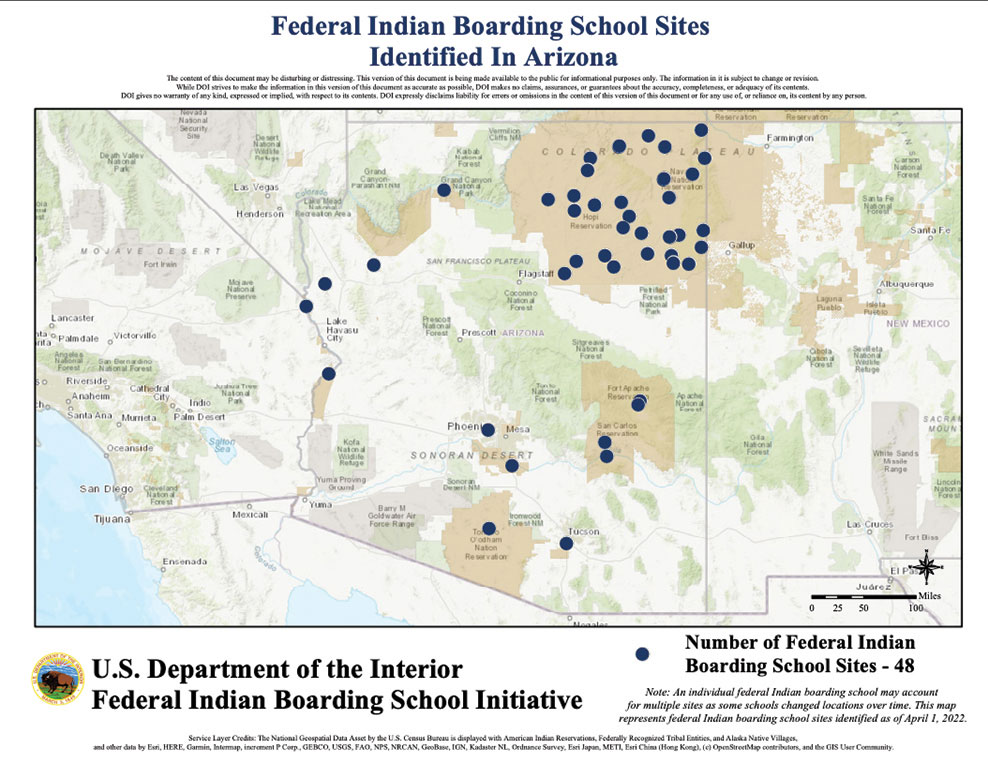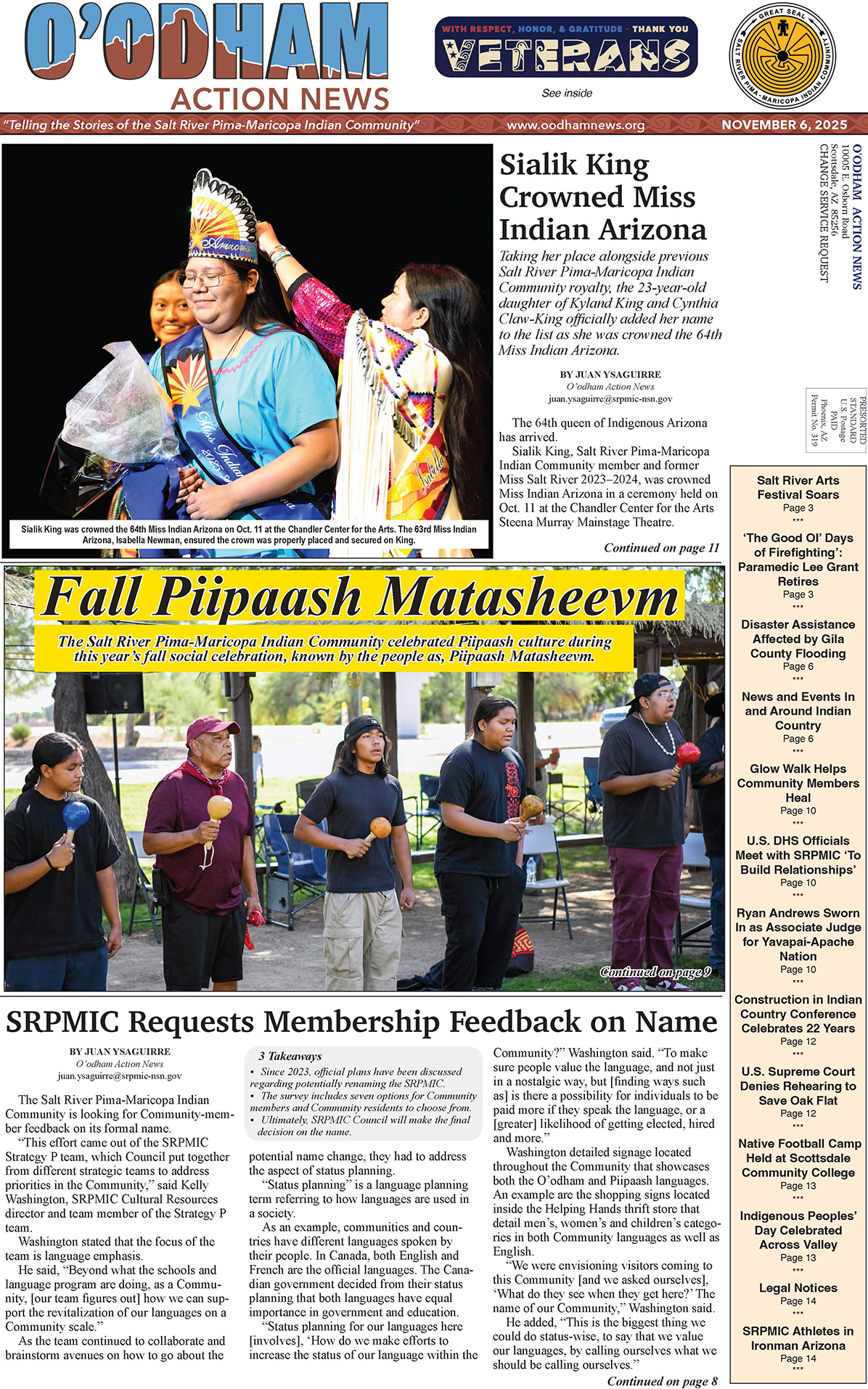VIEWS: 2790
June 17, 2022Federal Indian Boarding School Initiative Released by Interior Department
By Chris Picciuolo
O’odham Action News
chris.picciuolo@srpmic-nsn.gov
On May 11, the Department of the Interior (DOI) released Volume 1 of the comprehensive report and investigation into the Federal Indian boarding school (FIBS) system called the Federal Indian Boarding School Initiative.
The report is a result of the June 22, 2021, memorandum by Interior Secretary Deb Haaland directing the DOI to investigate and report on, by April 1 of this year, the scope of the boarding school system with a focus on the location of schools and burial sites and identification of children who attended the schools.
For the first time ever, an extensive inventory of federally operated schools was assembled that includes the general location and informational profiles of the schools.
The investigation so far has found that, from 1819 to 1969, the Federal Indian Boarding School system consisted of 408 schools across 37 states. As the investigation continues, the DOI said that it expects the number of identified burial sites to increase from the identified marked or unmarked burial sites at approximately 53 different schools across the system.
“The Salt River Pima-Maricopa Indian Community Tribal Historic Preservation Office is pleased that the Department of the Interior is taking steps to address the many horrific acts that the federal boarding school system inflicted upon Native youth throughout the years,” said Shane Anton, SRPMIC Tribal Historic Preservation Officer. “This includes the death of these individuals that occurred while in their care, and the callous way of treating them by either not fully reporting or falsifying the cause of death. It would appear there are unknown cemeteries of Native youth that their respective communities and families have no knowledge existed or that their loved ones are buried there. Hopefully this investigation and call for a report will help the Native communities and families locate members that haven’t been given the opportunity to conduct their traditional mortuary practices and give proper respect to the deceased.”
There were 48 federally operated boarding schools identified in Arizona, which include the Phoenix Indian School in Phoenix and the Pima Boarding School in Sacaton.
“The consequences of federal Indian boarding school policies—including the intergenerational trauma caused by the family separation and cultural eradication inflicted upon generations of children as young as 4 years old—are heartbreaking and undeniable,” said Secretary Haaland in a DOI statement. “We continue to see the evidence of this attempt to forcibly assimilate Indigenous people in the disparities that communities face. It is my priority to not only give voice to the survivors and descendants of federal Indian boarding school policies, but also to address the lasting legacies of these policies so Indigenous peoples can continue to grow and heal.”
According to the DOI statement, the FIBS system “deployed systematic militarized and identity-alteration methodologies in an attempt to assimilate American Indian, Alaska Native, and Native Hawaiian children through education.”
This included renaming Indian children from Indian to English names, cutting the hair of Indian children, discouraging or preventing the use of their religions and cultural practices, and organizing the children into units to perform military drills.
What’s Next?
Assistant Secretary of Indian Affairs Bryan Newland provided recommendations based on the report’s findings, in which he said the DOI must fully account for and renounce its role in forced assimilation of American Indian, Alaska Native and Native Hawaiian people.
Congress appropriated $7 million in new funds through the Fiscal Year 2022 Consolidated Appropriations Act to authorize action by the DOI to expand its investigation of the FIBS system.
The DOI plans to continue a full investigation, which includes conducting digitization, examination and analysis of records from both the American Indian Records Repository (AIRR) and the National Archives and Records Administration (NARA), which are working together for the first time to preserve Bureau of Indian Affairs records.
The Bureau of Trust Funds Administration (BTFA) identified 39,385 boxes in the AIRR with what the DOI says are “potentially responsive documents (approximately 98.4 million sheets of paper).”
Additional recommendations include identifying surviving FIBS attendees and documenting their experiences; supporting the protection, preservation, reclamation and co-management of sites across the FIBS system where the federal government has jurisdiction over a location, and more.
To read the full report, visit: https://www.bia.gov/sites/default/files/dup/inline-files/bsi_investigative_report_may_2022_508.pdf






